Installation
Welcome to the setup process for Genio. Whether you're looking to embark on developing applications in GenioWeb or Genio Backoffice the journey begins with a common set of steps to prepare your environment for development. This unified starting point ensures that the foundational elements necessary for a smooth installation are in place, regardless of the path you ultimately choose.
Contents
- Preparing the Environment
- Necessary Tools
- Testing
- Generating to a Repository (optional)
- Access GenioWeb Portal
Preparing the Environment for Development
The initial phase of setting up Genio is identical for both installation methods. It involves preparing your system to meet the prerequisites that are crucial for the tool's optimal performance. These steps typically include:
This phase is designed to ensure that your environment meets the minimum requirements necessary for the successful deployment of the tool. Follow these steps diligently to prepare your system:
- Check minimum system requirements;
- Enable necessary Windows Features;
- Install necessary tools;
- Setting the Database Management System (DBMS);
Minimum System Requirements
For optimal functioning of Genio, it should be installed on a computer with the following characteristics:
- Microsoft Windows 10
- 8GB RAM
- I5 or equivalent
- 40GB free disk space
- Internet connection
Windows Features
To optimize performance, Windows 11 ships with various features turned off by default, as the typical user may not require them for everyday tasks. However, to fully harness the capabilities of Genio, you may need to activate certain components. Below, we outline the steps to ensure your system is configured correctly:
Accessing Windows Features: Start by navigating to the features settings of your system. You can do this by typing “Turn Windows features on or off” into the search bar. This action will bring up a list of Windows features that can be enabled or disabled.
Comparing and Enabling Required Features: In the Windows Features window, you'll find a list of optional components. Cross-reference this list with the features we've marked as necessary for Genio. Tick the checkboxes next to the required features to enable them.




Restart Your Computer: After validating and installing all the necessary features, it's important to restart your computer. This ensures that the changes take effect and the system is fully prepared.
Necessary tools
Visual Studio
Genio generates source code and project files that are fully readable and compatible with a variety of Integrated Development Environments (IDEs), tailored to the specific technologies employed in your development process. When building MVC applications, Microsoft Visual Studio (VS) is the required IDE.
For those engaging in educational or testing activities, the Community Edition of Microsoft Visual Studio is readily accessible and can be downloaded from the official website https://visualstudio.microsoft.com/vs/.
This edition provides a comprehensive suite of tools and features suitable for such purposes, ensuring a robust and efficient development experience.
.NET
.NET unifies the SDK, base libraries, and runtime across mobile, desktop, IoT, and cloud apps. The download is available at: https://dotnet.microsoft.com/en-us/download/dotnet/thank-you/sdk-8.0.204-windows-x64-installer
For versions beyond 338.14, it is recommended to utilize .NET 8. Further details can be found at here.
NodeJs
Node.js is an open-source and cross-platform JavaScript runtime environment. It is a popular tool for almost any kind of project! Genio needs NodeJs to compile all libraries of the project.
Go to https://nodejs.org/ and choose the LTS version.
pnpm
The pnpm (Performant NPM) is a forward-thinking package management solution designed to address the challenges posed by traditional package managers.
In simple terms, pnpm downloads all project dependencies during the project compilation.
To install pnpm via npm (Node.js) on Windows:
- Open the command line from the Start menu.
- Check if pnpm is already installed by typing
pnpm. - If the command is not recognized or the version is outdated, enter
npm install -g pnpmto install the latest version.
Essential libraries and dependencies
This installation program developed by Quidgest installs some dependencies necessary to run our applications. The installation program can be downloaded at Setups_3.0.10.zip
Before beginning installation: Ensure you have administrator privileges (local or network).
- Once the file has been downloaded, it must be unzipped. Make sure you do not make any changes to the folder structure.
- Run the file “QuidSetups.exe”.
For versions beyond 338.14, it is recommended to follow the next steps:
- Select "Custom" for the installation mode.
- Select both options (“Client” and “Server”).
- Client machines: Only for customers with solutions using native Windows applications.
- Server machines: To run on servers where Quidgest solutions are installed.
- Check the next options on the list:
- Client -> Other: Crystal and its children.
- Server ->Web: Crystal and its children.
- Server ->Other: Reporting Services and its children
- Based on our previous selection it will be given a detailed listing of the components that will be installed on our server. Check if everything is all right and you can start the installation process by clicking on the “Install” button.
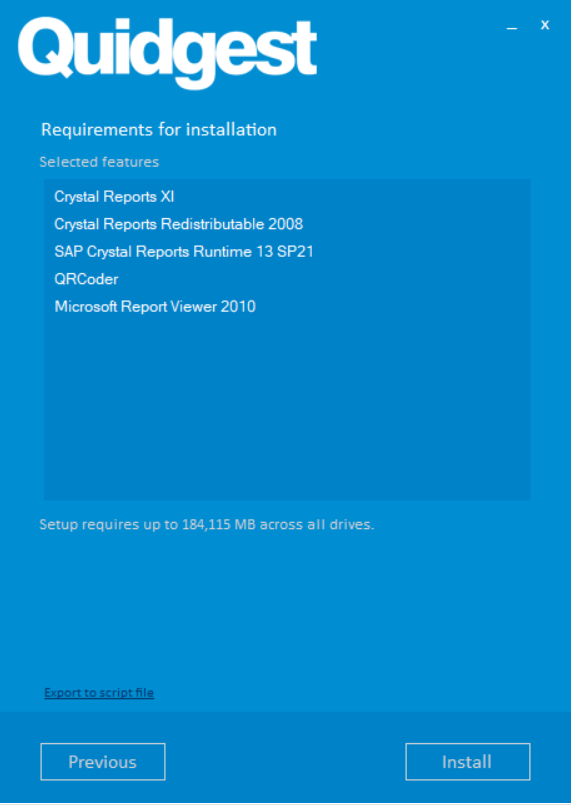
For versions under 338.14, it is recommended to follow the next steps:
- Select "Typical" for the installation mode.
- Select both options (“Client” and “Server”).
- Check all options: Other, Backoffice, MVC and Web.
- Other: Requirements for all platforms such as Microsoft Report Viewer
- Backoffice: Windows Applications.
- MVC: Web applications that use MVC technology.
- Web: Other web applications.
- Based on our previous selection it will be given a detailed listing of the components that will be installed on our server. Check if everything is all right and you can start the installation process by clicking on the “Install” button.
Microsoft SQL Server Management Studio
SQL Server Management Studio (SSMS) is an integrated environment for managing any SQL infrastructure. We use SSMS to query, design, and manage your databases and data warehouses on your local computer. In other words, to have access to the local server database, it is necessary to have this tool installed locally.
You can find the download of Microsoft SQL Server Management Studio (SSMS) at https://docs.microsoft.com/en-us/sql/ssms/download-sql-server-management-studio-ssms?view=sql-server-ver16
Database Management System (RDBMS)
SQL Server
Microsoft SQL Server is a relational database management system (RDBMS). Applications and tools connect to a SQL Server instance or database and communicate using Transact-SQL (T-SQL).
The Database Engine component of SQL Server is the core service for storing, processing, and securing data. The Database Engine provides controlled access and rapid transaction processing to meet the requirements of the most demanding data-consuming applications in your enterprise.
(https://learn.microsoft.com/en-us/sql/sql-server/what-is-sql-server?view=sql-server-ver16, 2023)
Genio is compatible with SQL Server 2008 R2 or later. However, it is advised always to use the latest version of SQL Server. You can get a free Developer edition of Microsoft SQL Server here: https://www.microsoft.com/en-gb/sql-server/sql-server-downloads Scroll down on the page and select the Developer option to download.
SQL Server Installation: Rules for Computer and Instance Name
WARNING: When installing an instance of Microsoft SQL Server, the name of the Computer (hostname) and the instance name must follow certain rules regarding allowed characters. Here are the key rules:
1. Rules for the Computer Name (Hostname)
Allowed Characters:
- Letters:
A-Z,a-z(case-insensitive) - Numbers:
0-9 - Hyphens:
-
Not Allowed:
- Spaces
- Special characters:
! @ # $ % ^ & * ( ) + = { } [ ] \ / : ; ' " < > , ? - Underscores (
_) are not recommended because they can cause issues with some network services.
Other Considerations:
- The computer name must start with a letter or number (not a hyphen).
- Maximum length: 15 characters for NetBIOS compatibility.
- The name should be unique in the network to avoid conflicts.
2. Rules for SQL Server Instance Name
Default Instance:
- Uses the computer name as the instance name (e.g.,
MACHINENAME).
Named Instance:
(e.g., MACHINENAME\INSTANCE)
Allowed Characters:
- Letters (
A-Z,a-z) - Numbers (
0-9) - Underscore (
_)
Not Allowed:
- Spaces
- Special characters:
\ / : * ? " < > | - Reserved words (e.g.,
"COM1","LPT1","PRN")
Instance Name Maximum Length:
- 16 characters
SQL Server Installation: Main steps
NOTE: Before you start the installation, check the rules regarding the naming of the Computer (hostname) and the SQL Server instance.
-
Run the SQL2022-SSEI-Dev.exe file
-
Select the Custom option.
-
Keep media location as C:\SQL2022 and press install.
- This may take a few minutes. Then, the SQL installation center window will open.
-
On the top left menu, click on the installation tab and select New SQL Server stand-alone installation.
-
When installing SQL Server, use the default setup options except when noted below.
- You don't need the Azure extension, so please uncheck the "Azure Extension for SQL Server".
-
Feature Selection:
- There are many features you can add to your server instance, but for this installation, just select the “Database Engine Services” option.
-
Instance Configuration:
- By default, a computer does not have any server instance installed, in this case, you should maintain the “Default instance” option selected.
- Selecting the default instance name will assume the same name as the computer name ([COMPUTERNAME] e.g., CURIOSITY).
- If you already have a server instance previously installed, choose the “Named Instance” option, and type a new name.
- The suggestion is “SQL[YEAR]” (E.g., SQL2025). In the end, the full name of your server is “[COMPUTERNAME]\SQL[YEAR]” (E.g., CURIOSITY\SQL2025)
- By default, a computer does not have any server instance installed, in this case, you should maintain the “Default instance” option selected.
-
Server Configuration / Collation
- SQL Server collation refers to a set of characters and character encoding rules. Genio uses "SQL_Latin1_General_CP1_CI_AI”, which means:
- Latin makes the server treat strings using ASCII.
- CP1 uses the Code Page 1252.
- CI is case-insensitive (“ABC” is equal to “abc”).
- AI is accent-insensitive (“á” is equal to “a”).
- Make sure that you choose the correct option. This setting makes it easy to search for data because data entry is subject to many accentuation errors.
- SQL Server collation refers to a set of characters and character encoding rules. Genio uses "SQL_Latin1_General_CP1_CI_AI”, which means:
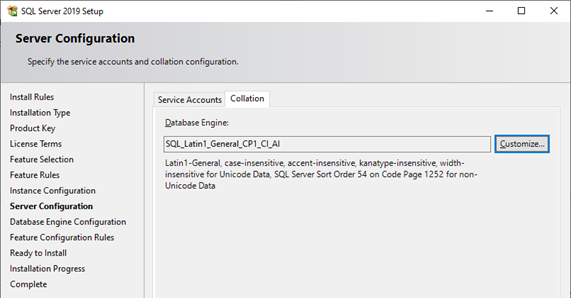

- Database Engine Configuration
- Server Configuration: In the first tab, “Server Configuration”, you should select in the Authentication Mode area, the Mixed Mode option, so that third-party SQL applications can access the databases created therein.
- The password here is based on the default user "sa" - it must have between 13-15 characters, including capital and small letters as well as numbers (don’t use special characters). This is only for configuration and installation, not for normal use.
- Also, add yourself (Add Current User) as SQL Server administrator.
- Server Configuration: In the first tab, “Server Configuration”, you should select in the Authentication Mode area, the Mixed Mode option, so that third-party SQL applications can access the databases created therein.
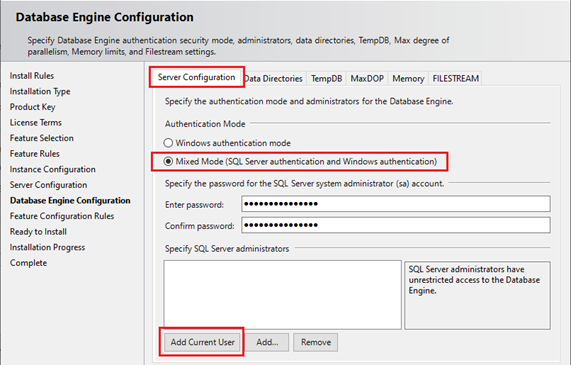
- Filestream: In the “FILESTREAM” tab of this form, select the technologies to be used for document recording.
- You should select all the options and make sure you do not change the Windows share name.
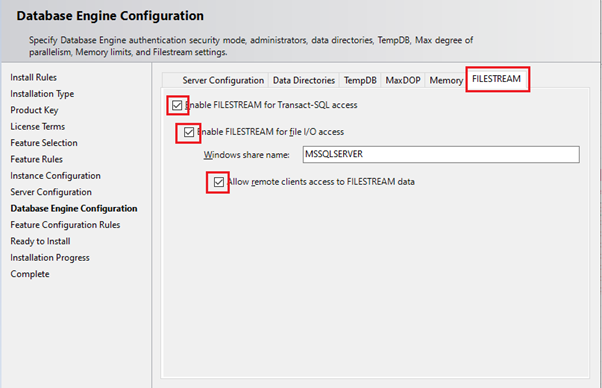
Creating an SQL Server Account
-
After you've completed the installation, proceed to create a new user account using SQL Server authentication.
- This account is crucial as it will be utilized in both SSMS and Genio. While you have the option to alter the password at a later stage, it's important to set it up carefully now.
- Username: Avoid using numbers or special characters.
- Password: Ensure that your password meets the following complexity requirements:
- 10 characters long.
- At least one capital letter and one small letter.
- At least one number.
- At least one special character.
- IMPORTANT NOTE: do not use any of the following special characters (to avoid errors on Genio): < (less than sign); > (greater than sign); & (and sign); ' (apostrophe or single quote); " (double quote).
- If you've added the "current user," log in using Windows authentication.
- Alternatively, use the 'sa' credentials provided here SQL Server - Step 9 for login.
-
There are two ways to create your account: by query or manually:
-
Account creation by query:
USE [master] GO CREATE LOGIN [set_Username] WITH PASSWORD = N'<set_Password>', DEFAULT_DATABASE=[master], CHECK_EXPIRATION=OFF, CHECK_POLICY=OFF; GO -
Account creation manually:
- On the "Object Explorer" window (a bar on the left side), expand the instance name.
- Right-click on the Security section and choose the option “new” followed by “new login”.
- In the General section, type a Login name (Username) and change the authentication type from “Windows authentication” to “SQL Server Authentication”.
- Then, type a Password and Confirm with the same Password.
- Note: create a password according to the conditions of complexity mentioned before.
- The options to enforce the password policy should be unchecked.
- At the end of the window, confirm the default language is “English – us_english”.
- In the Server Roles section, it is mandatory to give more permissions to this user. For that, you should select the “sysadmin” option.
-
- This account is crucial as it will be utilized in both SSMS and Genio. While you have the option to alter the password at a later stage, it's important to set it up carefully now.
- Testing credentials: Ensure you can log in with the credentials created previously.
Enabling Named Pipes and TCP/IP
For optimal and adaptable connectivity between the system and the database, enabling protocol bindings is essential.
- Open SQL Server Configuration Manager:
- You can find this in the Start Menu or by searching for it in Windows.
- In the SQL Server Configuration Manager, click on "SQL Server Network Configuration" on the left pane.
- In the list of SQL Server instances, select the instance for which you want to enable the protocols.
- In the right pane, you'll see a list of protocols.
- Right-click on the chosen protocol and select "Enable" from the context menu.
- You should enable all protocols (Shared Memory, Named Pipes and TCP/IP).
- For the changes to take effect, you need to restart the SQL Server service.
- Go to the "SQL Server Services" section in the left pane.
- Right-click on your SQL Server instance (it should be listed as SQL Server (instance_name)) and choose "Restart".


Testing
In the end of full nstallation, you can test with a test project. Just to ensure everything is well-installed. You can use one of yours downloaded project, or you can use this one.
Please follow these steps to set up and run the Project_Test solution:
- Begin by extracting the contents of the Project_Test.zip folder.
- After extraction, navigate to the Webadmin folder.
- Open the solution in Visual Studio.
- Configure the startup projects:
- Go to the solution properties.
- Select "Multiple startup projects."
- Set the action to start for both the Administration and ClientApp projects.
- Apply these configuration changes and then start the solution.
- If the setup is successful, you should see our Webadmin page open in your browser.
- Open the solution in Visual Studio.

- Navigate to the MYAPP folder.
- Open the solution in Visual Studio.
- Configure the startup projects:
- Go to the solution properties.
- Select "Multiple startup projects."
- Set the action to start for both the GenioMVC and ClientApp projects.
- Apply these configuration changes and then start the solution.
- If the setup is successful, you should see our Myapp page open in your browser.
Note: During the first launch, you may encounter SSL certificate prompts. Please accept these prompts as necessary.
Generating to a Repository (optional)
After testing, your development environment should be fully installed. However, to improve the user experience during development and testing, we strongly recommend using a repository for the generated files.
By generating files into a repository, you can pull updates into your local environment whenever needed, making web development faster and more efficient.
Check here to see what you need to configure!
Access GenioWeb Portal
To access GenioWeb, please navigate to GenioWeb Portal. Once there, log in using your designated credentials.
NOTE: If you don't have any credentials, please contact support.genio@quidgest.com
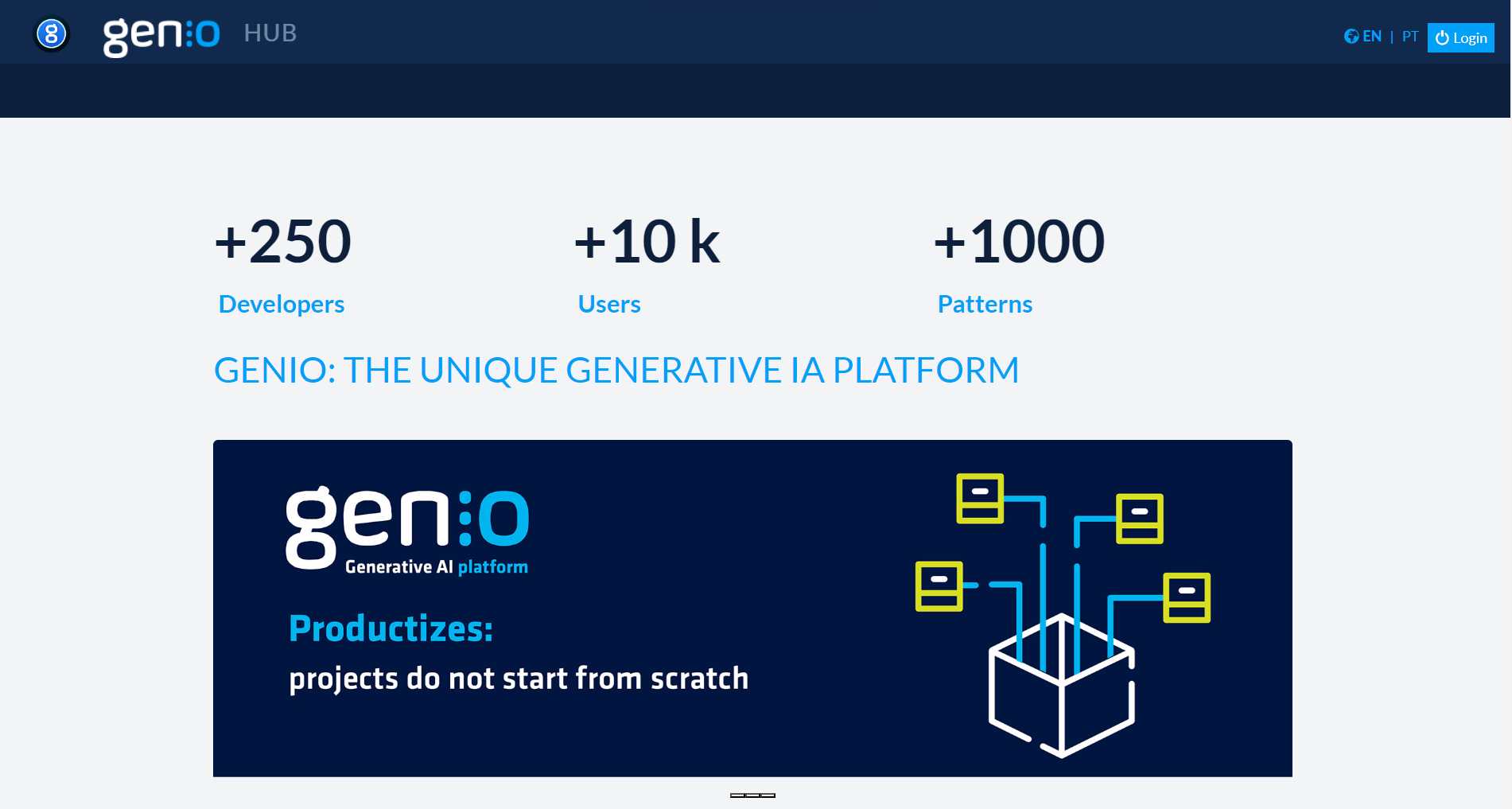
For more assistance, please contact support.genio@quidgest.com.
For further information, please visit our Quidgest webpage.